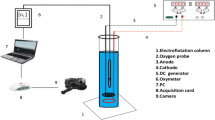Abstract
Electroflotation column is preferred in many chemicals, electrochemical and biochemical wastewater process treatment due to their simplicity in design, operation and maintenance. Indeed, it is very important to have a tool to determine and optimize the size distribution of the bubbles produced inside columns. In this context and in order to improve the performance of wastewater treatment by electroflotation process, the main objective of this study was to investigate the effect of current density and liquid phase electric conductivity on the bubble size distribution and on the bubble flow regime. For this a rectangular electroflotation column was used. The method of recording and the video image analyzing was used to determine the diameter and the rise velocity of the bubbles.
Similar content being viewed by others
References
Ghernaout, D., Naceur, M.W., and Aouabed, A., On the dependence of chlorine by-products generated species formation of the electrode material and applied charge during electrochemical water treatment, Desalination, 2011, vol. 270, p. 9.
Ma, L., Sun, C., Ren, J., Wei, H., and Liu, P., Efficient electrochemical incineration of phenol on activated carbon fiber as a new type of particulates, Russ. J. Electrochem., 2014, vol. 50, p. 569.
Ben Mansour, L., Ben Abdou, Y., and Gabsi, S., Effect of some parameters on removal process of nickel by electroflotation, Water Environ. Res. J., 2001, vol. 2, p. 51.
Merzouk, B., Yakoubi, M., Zongo, I., Leclerce, J.-P., Paternottee, G., Pontviannee, S., and Lapicquee, F., Effect of modification of textile wastewater composition on electrocoagulation efficiency, Desalination, 2011, vol. 275, p. 181.
Anissa, A., Ridha, L., and Amor, H., Feasibility evaluation of combined electrocoagulation/adsorption process by optimizing operating parameters removal for textile wastewater treatment, Desal. Water Treat., 2017, vol. 60, p. 78.
Ben Mansour, L. and Chalbi, S., Removal of oil from oil/water emulsions using electroflotation process, J. Appl. Electrochem., 2006, vol. 36, p. 577.
Bukhari, A.A., Investigation of the electro-coagulation treatment process for the removal of total suspended solids and turbidity from municipal wastewater, Bioresour. Technol., 2008, vol. 99, p. 914.
Merzouk, B., Yakoubi, M., Zongo, I., Leclerc, J.-P., Paternotte, G., Pontvianne, S., and Lapicque, F., Bubble size measurement in electroflotation, Miner. Eng., 2010, vol. 23, p. 1058.
Ren, L., Zhang, Y., Qin, M., Bao, S., Wang, P., and Yang, C., Investigation of condition-induced bubble size and distribution in electroflotation using a highspeed camera, Int. J. Min. Sci. Technol., 2014, vol. 24, p. 7.
Zhu, C., Hu, C., Lu, J., Wang, X., Li, H., and Chen, T., Electrocatalytic degradation of bisphenol a in aqueous solution using ß-PbO2/Ti as anode, Russ. J. Electrochem., 2015, vol. 51, p. 353.
Zabel, T., Advantages of dissolved air flotation for water treatment, J. Am. Water Works Assoc., 1985, vol. 77, p. 42.
Jia, B.J., Zhou, J.T., Zhang, A.L., et al., Novel electrochemical heterogeneous catalytic reactor for organic pollutant abatement, Russ. J. Electrochem., 2007, vol. 43, p. 296.
Kolesnikov, V.A., Varaksin S.O., and Kryuchkova, L.A., Electroflotation extraction of valuable components from wash waters of electroplating works, with water recycling, Russ. J. Electrochem., 2001, vol. 37, p. 760.
Kyzas George, Z. and Matis Kostas, A., Electroflotation process: A review, J. Molec. Liquids, 2016, vol. 220, p. 657.
Samantha, G.C., Dutra Achilles, J.B., and Monte Marisa, B.M., The influence of some parameters on bubble average diameter in an electroflotation cell by laser diffraction method, J. Environ. Chem. Eng., 2016, vol. 4, p. 3681.
Ksentini, I., Kotti, M., and Ben Mansour, L., Effect of liquid phase physicochemical characteristics on hydrodynamics of an electroflotation column, Desalin. Water Treat., 2013, vol. 51, p. 1.
Lin, B., Recke, B., Knudsen, J.K.H., and Jorgensen, S.B., Bubble size estimation for flotation processes, Mineral Eng., 2008, vol. 21, p. 539.
Labbafi, M., Thakur, R.K., Vial, C., and Djelveh, G., Development of an on-line optical method for assment of the bubble size and morphology in aerated food products, Food Chem., 2007, vol. 102, p. 454.
Ding, Y.G., Lu, X., and Deng, F.L., Numerical simulation with a CFD-PBM model of hydrodynamics and bubble size distribution of a rectangle bubble column, Am. Soc. Mech. Eng., 2016, vol. 5, p. 30.
Schafer, R., Merten, C., and Eigenberger, G., Bubble size distributions in a bubble column reactor under industrial conditions, Exp. Therm. Fluid Sci., 2002, vol. 26, p. 595.
Kendoush, A.A., Mohammed, T.J., and Abid, B.A., Experimental investigation of the hydrodynamic interaction in bubbly tow phase flow, J. Chem. Eng. Processing, 2004, vol. 43, p. 23.
Malysa, K., Krasowska, M., and Krzan, M., Influence of surface active substances on bubble motion and collision with various interfaces, Adv. Colloid Interface Sci., 2005, vol. 114, p. 205.
Prakash, A., Margaritis, A., and Li, H., Hydrodynamics and local heat transfer measurements in a bubble column with suspension of yeast, Biochem. Eng. J., 2001, vol. 9, p. 155.
Sentini, K., Hmidi, N., Hajlaoui, N., and Ben Mansour, L., Hydrodynamic study of an electroflotation column operating in continuous mode, I.J.I.R.T., 2014, vol.1, p. 109.
Painmanakul, P., Loubièrea, K., Hébrarda, G., Peuchot, M.M., and Roustan, M., Effect of surfactants on liquid-side mass transfer coefficients, Chem. Eng. Sci., 2005, vol. 60, p. 6480.
Issaoui, R., Ksentini, I., Kotti, M., and Ben Mansour, L., Effect of current density and oil concentration on hydrodynamic aspects in electroflotation column during oil/water emulsion treatment, Water Treat. Demineral. Technol., 2017, vol. 39, p. 166.
Author information
Authors and Affiliations
Corresponding author
Additional information
Published in Russian in Elektrokhimiya, 2019, Vol. 55, No. 5, pp. 523–528.
The article is published in the original.
Rights and permissions
About this article
Cite this article
Hajlaoui, N., Ksentini, I., Kotti, M. et al. Experimental Study of Current Density and Liquid Phase Electric Conductivity Effects on Bubble Size Distribution in an Electroflotation Column. Russ J Electrochem 55, 358–363 (2019). https://doi.org/10.1134/S1023193519040025
Received:
Revised:
Accepted:
Published:
Issue Date:
DOI: https://doi.org/10.1134/S1023193519040025




